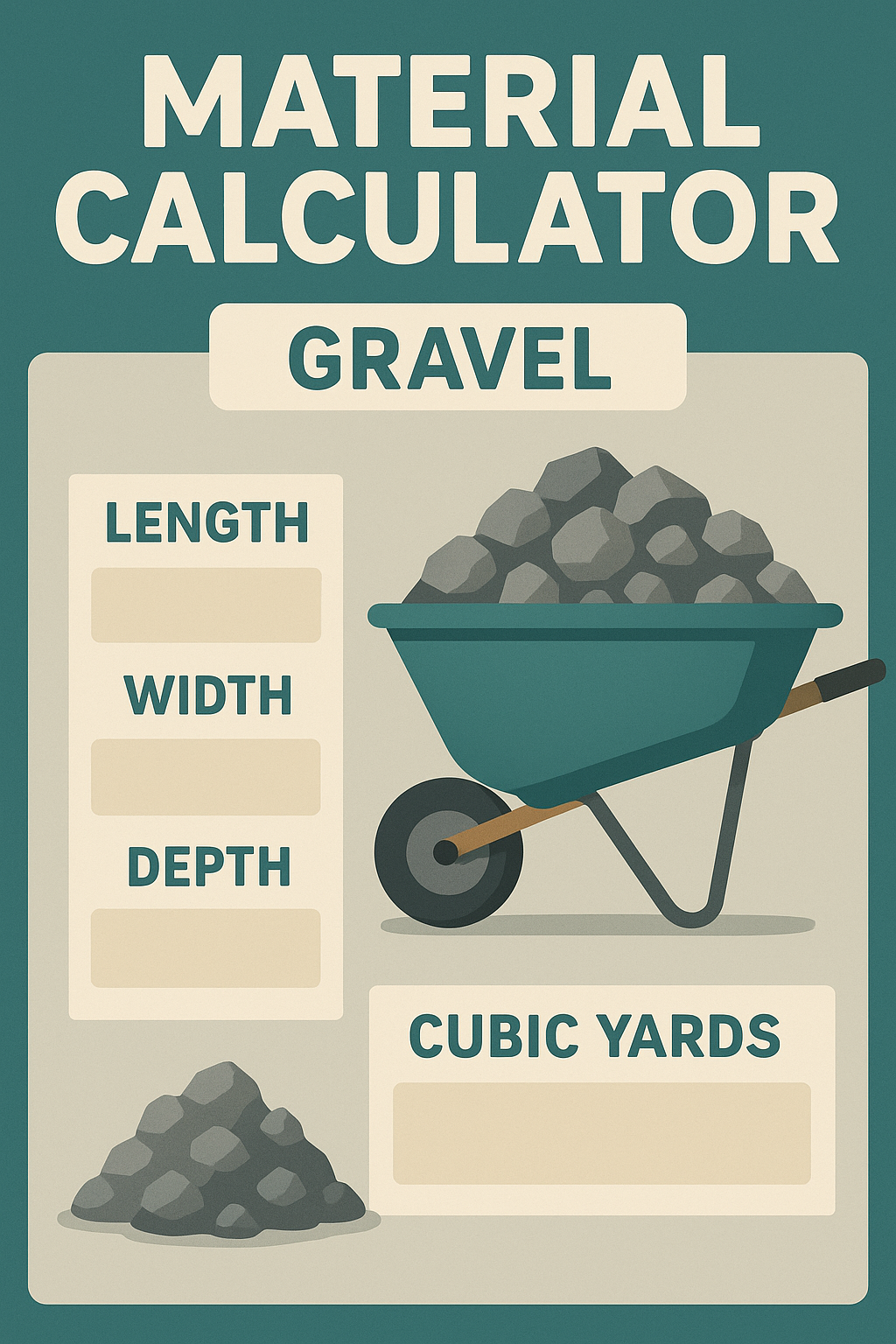Free Material Calculator Gravel Online
Gravel is a foundational material used in construction, landscaping, and drainage projects. Whether you’re creating a driveway, filling a trench, or laying the base for a patio, it’s critical to know how much gravel you need before ordering. The Construction Calculators platform includes a Material Calculator for Gravel that makes it easy to estimate the amount of gravel required based on your project’s area dimensions and desired depth—saving time, cutting waste, and ensuring accurate planning.
This calculator saves time, cuts costs, and ensures you don’t under- or over-order. In this blog, we’ll walk through how it works, formulas involved, unit conversions, and common use cases.
What Is a Gravel Material Calculator?
A Gravel Material Calculator is a digital tool used to estimate the volume and weight of gravel needed for a project. You input the length, width, and depth of the area to be filled, and it outputs the gravel volume in cubic feet, cubic yards, or tons.
The calculator uses simple geometric formulas and average gravel densities to help homeowners, contractors, and landscapers plan their purchases efficiently.

Why You Need to Calculate Gravel Accurately
Gravel isn’t cheap, and ordering too little means extra delivery fees. Too much gravel can result in waste, clutter, and storage issues. Accurate gravel estimation helps:
- Avoid material shortages and work delays
- Save money on excess materials and trucking fees
- Improve time and labor efficiency
- Ensure consistent coverage and project quality
Formula for Gravel Volume
To calculate the amount of gravel needed, use the following formula: $$\text{Volume (cubic feet)} = \text{Length (ft)} \times \text{Width (ft)} \times \text{Depth (ft)}$$
To convert cubic feet to cubic yards: $$[
\text{Volume (cubic yards)} = \frac{\text{Cubic Feet}}{27}
]$$
To convert cubic yards to tons (based on average density): $$\text{Tons} = \text{Cubic Yards} \times 1.4$$
(Note: Gravel density ranges from 1.3 to 1.5 tons/yd³ depending on type)
Step-by-Step Example
Project: Filling a driveway base
- Length = 40 ft
- Width = 12 ft
- Depth = 6 inches = 0.5 ft
Step 1: Calculate Volume in Cubic Feet
$$40 \times 12 \times 0.5 = 240 \, \text{cu ft}$$
Step 2: Convert to Cubic Yards
$$[
\frac{240}{27} = 8.89 \ \text{cu yd}
]$$
Step 3: Convert to Tons (Gravel at 1.4 tons/cu yd)
$$8.89 \times 1.4 = 12.45 \, \text{tons}$$
You would need approximately 12.5 tons of gravel for the project.
Common Gravel Depth Guidelines
| Application | Recommended Depth |
|---|---|
| Driveway base | 4–6 inches |
| Driveway top layer | 2–3 inches |
| Walkway/path base | 3–4 inches |
| French drain/trenching | 12–24 inches |
| Patio base | 4–6 inches |
Gravel Type and Density
| Gravel Type | Approx. Density (tons/cu yd) |
|---|---|
| Pea gravel | 1.3 |
| Crushed stone | 1.4 |
| Drainage gravel | 1.5 |
| Limestone gravel | 1.4 |
| Granite gravel | 1.6 |
Always verify with your supplier, as density affects tonnage significantly.
Tips for Ordering Gravel
- Round Up: Always order at least 5–10% more than needed to account for compaction and leveling.
- Ask About Delivery Minimums: Some suppliers require a minimum tonnage.
- Choose the Right Size:
- ¾″ for base layers
- ⅜″–½″ for surface paths
- Coarser stones for drainage
- Compact in Layers: For thick applications, apply and compact gravel in multiple lifts.
Frequently Asked Questions
How many cubic yards are in a ton of gravel?
On average, 1 ton of gravel = 0.714 cubic yards, assuming 1.4 tons per cubic yard. To convert: $$\text{Cubic Yards} = \frac{\text{Tons}}{1.4}$$
How much gravel do I need per square foot?
$$\text{Cubic Feet} = \text{Area (sq ft)} \times \text{Depth (ft)}$$
Example: $$100 \times 0.25 = 25 \ \text{cu ft} = 0.93 \ \text{cu yd}$$
What depth should I use for gravel paths?
Use 3 inches for walkways or paths, and 6 inches for driveways or load-bearing surfaces.
Is gravel cheaper than concrete?
Yes, gravel is generally cheaper and easier to install. It’s also permeable, which makes it ideal for drainage.
Related Calculators
Pair the Material Calculator Gravel with these tools for complete planning:
- Concrete Volume Calculator – For pads, footings, and slabs
- Sand Calculator – For leveling sand over gravel
- Paver Calculator – When laying stone or brick on a gravel base
- Drainage Rock Calculator – For trench and landscape projects
Conclusion
The Material Calculator for Gravel simplifies the task of estimating how much gravel your project needs. Just enter the area dimensions and depth, and the calculator returns accurate results in cubic yards, tons, or cubic feet. Whether you’re installing a driveway, trenching for drainage, or preparing a foundation base, this tool helps you save time, money, and materials. Available on the Concrete Calculators platform, it pairs well with additional tools like the Epoxy Calculator for coatings and the Paver Calculator for outdoor surfacing, giving you complete control over your material estimates from start to finish.
Measure twice, calculate once, and get your project rolling smoothly with the right amount of gravel from the start.
